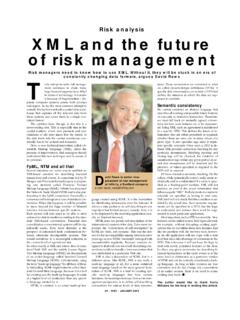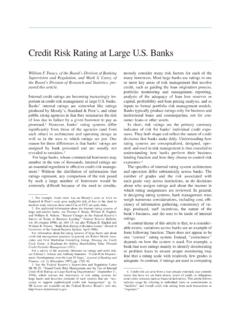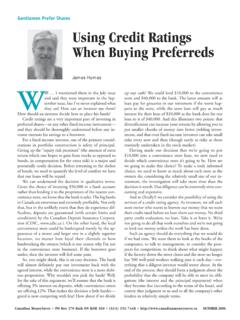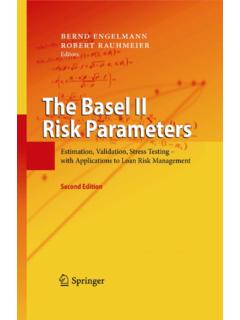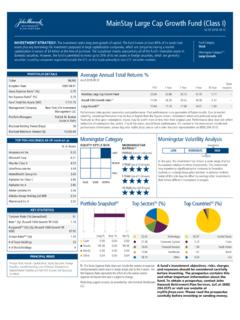Transcription of l Risk analysis Is 8% for all seasons? - dmrra.com
1 MAY 2003 RISK85lRisk analysisIn recent months, this column has con-sidered how introducing greater risksensitivity into the Basel capital Accordcould accentuate the business Gordy, senior economist at the USFederal Reserve Board, has argued that, inpractice, required capital will be smoothedover the business cycle, since the conse-quences of not doing so are simply toosevere. He sensibly maintains that theissue is how to do this with the least dam-age to the alignment of regulatory and eco-nomic capital and to the integrity of banks internal credit rating processes. He em-phasises that, for all its shortcomings,Basel II is the first modern and standard-ised metric of credit portfolio risk. If doneproperly, it has signal value across timeand across institutions that is important topreserve. He argues that there are threeways to address the cyclicality first is to smooth the inputs by, forexample, demanding through-the-cycle es-timates of parameters to make them lesscyclical.
2 This breaks the link between therating system and a bank s actual currentrisk. It is rather like saying the seasonallyadjusted temperature in Minnesota in bothJanuary and July is zero degrees Celsius. Itmay be true, but it doesn t provide muchinformation on what to wear when you gooutside. Such a rating scheme ignores valu-able current information and makes the re-sults virtually useless for many pricingdecisions. It also undermines the basis forback-testing by clouding the issue of ex-actly what actual realisations are the ap-propriate historical second is to smooth the capital cal-culation model by, for example, reducingthe derivative of the risk weight as a func-tion of the probability of default. This ap-proach preserves the signal value ofpoint-in-time parameter estimates, but re-duces the effectiveness of the resultingcapital requirement as a current measureof a bank s capital third is to adjust the regulatoryminimum capital ratio over the suggests five possible ways of ac-complishing this.
3 Fix regulatory capital charges at the in-ception of a loan. (To such a regime, Gordysuggests adding the requirement to disclosethe minimum regulatory capital based oncurrent ratings.) While preserving risk sen-sitivity on new loans, this approach opensmany opportunities for regulatory arbi-trage. It creates asymmetric incentives torefinance after an upgrade but not a down-grade. If the original capital charge wastransferable upon sale of a loan, this woulddistort pricing in the secondary market. Ifit was not transferable, it would discourageeconomically desirable risk diversificationwhen one or both parties stood to lose afavourable regulatory capital treatment. Smooth capital requirements at the in-strument level. In effect, this approachwould set the capital requirement for aninstrument based on a declining weight-ed average of current and past more responsive to current condi-tions than the previous method, it alsocreates both capital arbitrage opportuni-ties and distortions in the risk transfer mar-ket.
4 This approach also implies anincrease in the complexity of the calcula-tion and in auditing it effectively. Smooth capital requirements at theportfolio level. This approach estimates arequired capital ratio implied by currentparameter estimates, but the actual re-quired capital ratio would be a decliningtime-weighted average of these of both current and smoothedrequirements could be mandated. Thisapproach also preserves relative risk oncurrent loans and accommodates bank-specific cyclical influences. Being simpleto implement, it creates no additional bur-den in auditing the calculation. Con-versely, it could cause anomalies withlarge shifts in the balance sheet and wouldbe slow to boost required capital in theface of a deteriorating credit culture. Counter-cyclical indexing. This wouldallow the 8% ratio applied to risk-adjustedassets to vary based on a bank-specificcyclical variable.
5 This preserves risk sensi-tivity, avoids introducing capital arbitrageopportunities and preserves the consisten-cy of risk-weighted assets over time. Onthe other hand, an appropriate index mightbe hard to define for many large banks, andsuch indexes might need to be revised formany banks in light of specific experience. Discretionary rule. Realistically, nation-al regulators will not seriously aggravate adomestic economic contraction to defenda mechanical bank capital rule. Gordy ar-gues, and I agree, that it is better to makethis explicit. Supervisors could demandgradual increases in minimum capital ra-tios during expansions and allow for a mea-sured pace of reductions during recessions,all of which would have to be made pub-lic and justified based on cyclical condi-tions. It is highly unlikely that this wouldlead to a competitive devaluation of stan-dards in an increasingly risk-sensitiveworld.
6 It would also preserve the signalvalue of consistently published risk-weight-ed assets across banks and over time. In ef-fect, supervisors would mandate a gradualbuild-up of capital buffers during goodtimes and release them during periods ofeconomic stress. This could be a very pow-erful monetary policy tool. If used pru-dently during recessions, particularly if thisfollowed a period of gradual increases inthe capital ratio, it is unlikely that marketswould be spooked into losing confidencein the banking sector. In addition, with in-creased disclosure mandated under PillarIII, investors would already be aware of thecapital condition of banks, both individu-ally and collectively, in any case. If the pricing and market-signallingvalue of a consistent and reasonably so-phisticated credit risk assessment regimeare to be preserved, banking regulatorsshould step up to the challenge of dis-cretionary counter-cyclical adjustments tothe minimum required capital ratio.
7 Is 8% for all seasons? Considering the potential pro-cyclical impact of Basel II and the limited effectiveness ofcountervailing influences, David Rowe concludes that making the 8% ratio of capital-to-risk-adjusted-assets a discretionary policy variable should be part of the new capital AccordDavid Rowe is group executive vice-president for risk management at SunGard Trading and Risk Systemse-mail.


